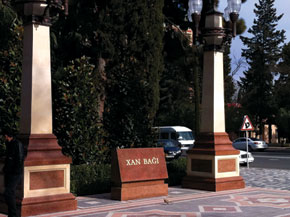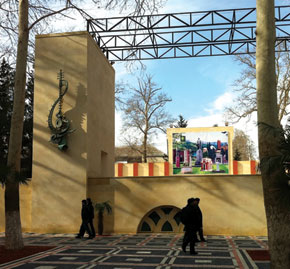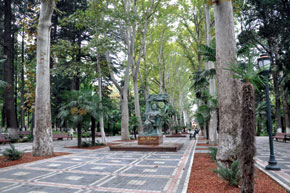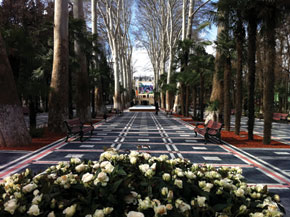 Gardens and parks are an important aspect of Azerbaijani culture and one of the most important is the 6 hectare garden in Ganja, one of the second city’s best-known landmarks. It really is a cultural landmark, described by geologist Mirali Qashqay as a natural monument bestowed upon the city.
Gardens and parks are an important aspect of Azerbaijani culture and one of the most important is the 6 hectare garden in Ganja, one of the second city’s best-known landmarks. It really is a cultural landmark, described by geologist Mirali Qashqay as a natural monument bestowed upon the city.This Ganja park features frequently in historical sources, appearing variously as the Khan’s or Sardar’s Garden, and has had its share of historical tribulations. Its structure, water supply and natural resources have undergone major changes during foreign intrusions. Ganja has been invaded at various points in its history and the central park rarely escaped lightly. The city’s landmarks, including the Khan’s Garden, even the city itself, have been renamed repeatedly by various rulers in the cause of their own glorification.
Ganja City’s Executive Authority and the Regional Centre of the National Academy of Sciences recently took on staff, including a working group of leading experts, to compile an Encyclopaedia of Ganja Monuments. Their mammoth task to locate, investigate and promote the region’s landmarks is already underway and hundreds of monuments have been tagged and categorised. The Khan’s Garden is high on the list.
Guard and garden
Its historical role is underlined by the remains of the 16th century Ganja fortress which lie to the right of the entrance. A small section of the fortress, the ten-pointed Shirali Bey Tower, once more than 13 km. long, has been preserved. Many people see a parallel in the building of the fortress and the layout of the garden. A number of sources indicate that the fortress was founded in 1588 and some believe that the garden was laid out at the same time. Farhad Pasha, son of Mehmet Pasha, is credited by some as the designing genius, but it is more likely that he did not have such a direct role in its creation.
There is, however some coincidence in the destinies of the fortress and the garden, both their fates were affected by invasions of the city. Fortresses were necessary for the defence of small territories, to be more exact, for the protection of the most important cities. It happened many times in history that invaders managed to occupy the rest of the land but were brought to a halt at Ganja. Before the Russian occupation of January 1804 the city was a strong bulwark against invading forces. However, after the Russian occupation the fortress lost strategic importance, given the strength of forces in the Caucasus. Fortresses were also reminders of the region’s previous independence. The new rulers were not happy with this symbol of the struggle against the Russian occupation.
Origins
There are images of the park (sometimes referred to as Khan’s Garden sometimes as Sardar’s Garden) in various paintings; one, dating back to 1847, shows some people at leisure, but others carrying arms; the latter were undoubtedly garden guards. Their presence indicates that the park was a recognised place of recreation. This work is actually quite informative. There are plane trees on the right and left of an avenue. Although the painting is dated 1847 the trees are more than one hundred years old. This clears up a dispute about origins – Khan’s Garden or Sardar’s Garden? The painting displays the actual condition of the garden at that time and indicates that the Sardar’s Garden was heir to the Khan’s Garden. If we recall that Javad Khan came to power in 1785, then those plane trees must have witnessed even earlier periods of the city’s history. The park existed before Ziyadoglular rule (the Ziyadoglular ruled the Ganja beylerbeylik, which was the administrative territorial unit of the Safavids,1501-1736, and they took good care of it).
It cannot be true that the park was laid out in 1847 by order of Prince M. S. Vorontsov (1844-1854), governor-general of the Caucasus (he was also known as the Sardar - in English, vicegerent – ed.)
Some sources declared the park to be the most beautiful garden in Southern Russia; they were not describing the founding of a city park but changes being made to its structure. In that phase of town planning Ganja was covered in parks and gardens. Thus the park was named after the Sardar, but not created by him. This is confirmed by the order On the naming of the garden in Yelizavetpol from 1847 in honour of the Caucasian governor-general, M. S. Vorontsov which indicates that the name was being Russified (following the Russian occupation the city’s name was changed to Yelizavetpol – ed.) From facts known about the history of the park it may be supposed that it was founded in earlier times, in the 10th century (996).
Creation, destruction, creation…
After it was named the Sardar’s Garden in 1847, the State Bank of Russia paid out 2,350 roubles to bring in 1,200,000 trees, fruit trees, flowers and ornamental bushes of various kinds from Crimea.
The park had been damaged by gunfire from General Tsitsianov’s troops during the occupation of Ganja in 1804 and the Russian-Iranian war of 1826-1828. Plane trees more than 400 years old were burned and destroyed. By 1869, documents of the period record that there were 5,000 plants, including 80 species of trees and bushes, there.
In 1873 architect I.I.Krijishtalovich worked on a new general plan for Ganja. Emperor Alexander III (1881-1894) signed the project. This time more exotic and new species of trees and flowers, including the black locust, Catalan, Cedar and Eldar pine-trees, Sabine pine, pomegranate, Japanese date palm and oleander were planted in the park. When Krijishtalovich was appointed chief architect statues began to appear there and in 1899 many ornamental plant species were brought from Batumi.
There was actually another Khan’s Garden in the Boyuk Bagban (Great Gardener) district of Ganja, but it was subsequently built over to create a residential area. Some of its trees were moved to the central garden, which has even been celebrated in folk songs for its deep water (springs) and coolness. Its width and length and the stamina of its trees were also praised, as were its cypress trees.
Plane trees are Ganja’s most important arboreal feature. There is a long history of references to Ganja plane trees and Azerbaijan’s Cabinet of Ministers adopted a decision on 16 March 1982: On state protection of Eastern plane trees over 100 years old as monuments of nature. 240 of these trees are considered to be natural monuments in the city, including the 1500-year-old Duldul tree in Ganjabasar.
1899 saw the commencement of renewal work in the Khan-Sardar Garden, initiated by the city zemstvo (local government) administration. The park was re-established and some small changes were made to its structure. Further changes came later.
Plane variety
The Khan’s garden is now one of Ganja’s central attractions. As Vahid Guliyev writes, when you enter the Khan’s Garden your attention is caught by the plane-tree alley, unique in the Southern Caucasus for its layout and fan-shaped palms. Among them are high Himalayan Cedars reaching for the skies, Himalayan Pines with their characteristically beautiful hanging branches covered with long needles. As well as these, the evergreen cypresses, Pitsunda and Crimean Pines, black pines, the Caucasian Palms, various species of white pines, Pekelman Firs, Satin Cedars, Eastern Thuyas and other evergreen trees and bushes make the garden especially beautiful. There are many and various broad-leaved trees. The most prominent of these trees and bushes were selected so that when the blossom or other attractive feature of one species fades another takes over. Finally, of course, the Khan’s Garden has a key role in keeping the city’s air clear and protecting its inhabitants from the hot sun in summer and the cold winds of winter.
Literature
M.Dadash-zadeh The Spiritual Culture of the Azerbaijan Nation in the Middle Ages (historical ethnographic study). Baku, 1985
F.Ahmadov Historical Memories of Ganja. Ganja, 2007
F.M. Aliyev Northern Cities of Azerbaijan in the 2nd Half of the 18th Century. Baku, 1960
Ganja Magazine. 2005, issue 2
S. Shukurov. The Material Culture of Ganja. Baku, 1986
M.Guseynov, M.Bretanitskiy, A.Slam-zadeh. The History of Azerbaijani Architecture. M., 1963
M.S. Fatullayev. Town Planning and Architecture in Azerbaijan in the19th and Early 20th Centuries. Baku, 1986





.jpg)